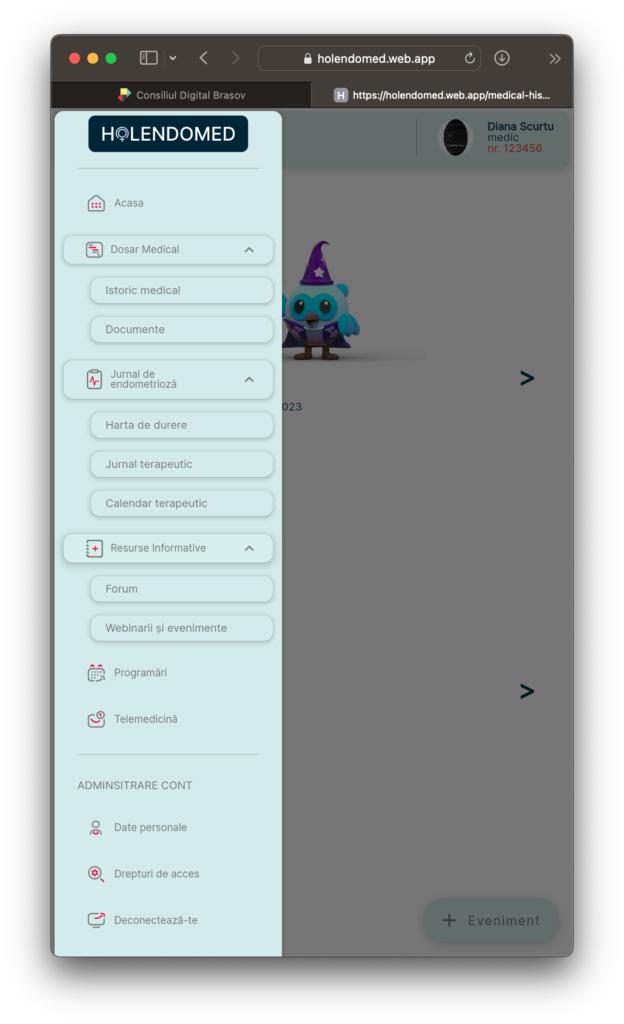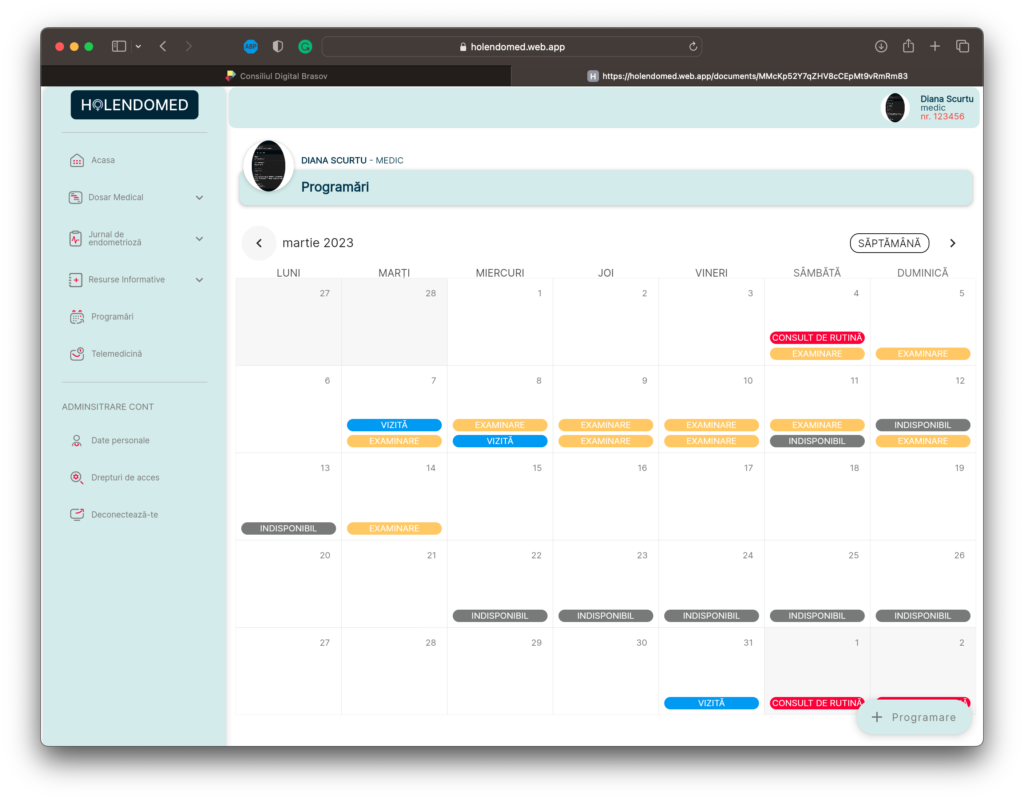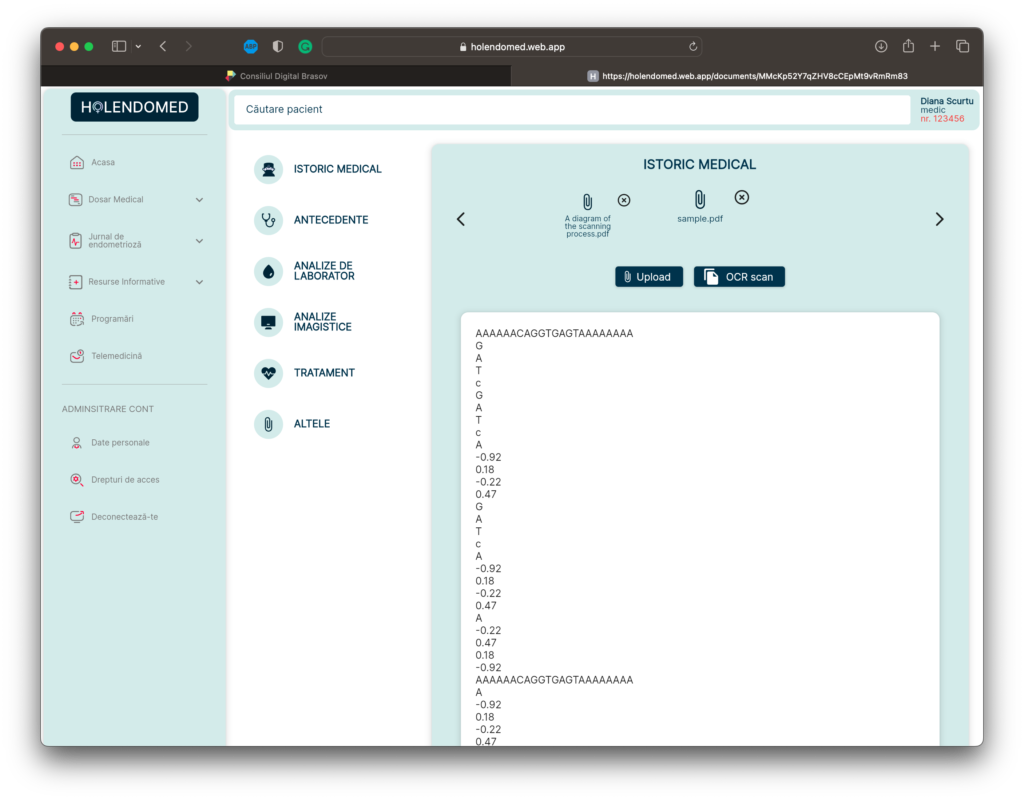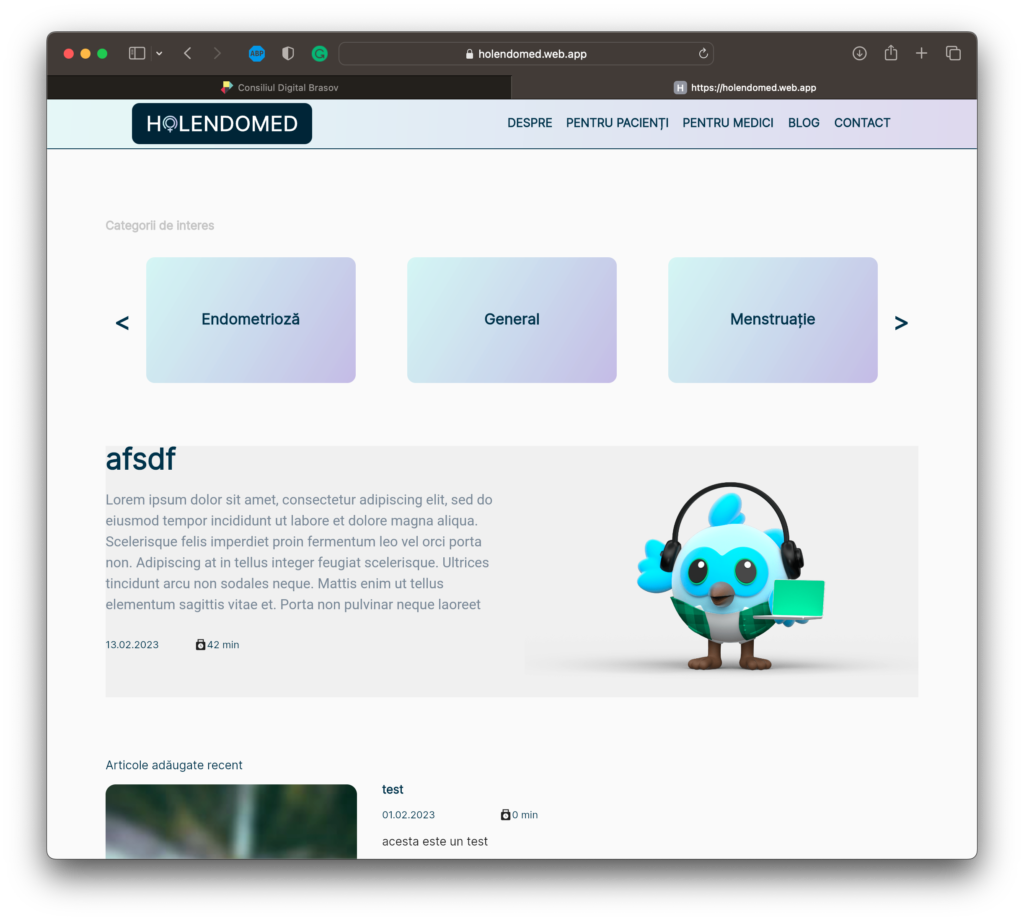General description
The Holendomed platform is intended for patients from a clinic specialized in endometriosis; endometriosis being achronic disease, which globally affects 10% of women, according to the World Health Organization (WHO).
Thus, the purpose of the platform is to offer patients, as well as medical staff, the necessary tools in terms of monitoring the most frequent symptoms, through its own calendar, with the possibility of entering details and their location.
At the same time, the application aims to streamline the process of making appointments at the clinic, through online appointments and email notifications, but also informing users through access to the forum and blog posts.

The blog provides valuable information about endometriosis and related topics, helping patients stay informed and up-to-date with the latest developments in the field. The forum is a space where patients can connect with doctors, explain the symptoms they have and get answers from the medical staff.
The calendar allows patients to easily track their symptoms and schedule appointments with healthcare professionals.
With its intuitive design and advanced features, the platform provides medical information, informative resources, simplifying the complex process of managing endometriosis and makes it easier for patients to access the care they need.













Technical description
The application will be intended for two types of users: patients and medical personnel.
Patients can view their complete medical history, upload medical documents in pdf format from other medical services (medical letter, medical prescription, results of paraclinical investigations, imaging investigations), visualize treatment and treatment scheme, mark relevant events in real time through a form (pain, menstrual cycle, data on fertility and treatment). At the same time, they have access to documented and scientifically validated informative resources about endometriosis, treatment, complications, risks and can choose an available day and time to schedule a consultation.
Doctors can view a patient’s complete medical history with her consent; to modify or adddiagnostics, to upload medical documents(medical letter, medical prescription, results of paraclinical investigations, imaging investigations), to define the treatment scheme, to upload scientifically documented articles about endometriosis, treatment, complications, risks, to answer patients’ questions or uncertainties.
Application design will include data and user type analysis, interface design, and application logic development. The development phase involves integrating components, testing the application, and deploying it. Finally, the application will be maintained and updated periodically to ensure that it works as expected.
Structure of the Platform
At a general level, the online platform consists of 3 modules: presentation website (homepage, information for doctors/patients, and blog), patient interface, and medical staff interface (admin, with full rights).
Features
For the patient:
- User interface
- Log-in system (with email or social network account)
- Dashboard
- Electronic Medical File Mode – uploading medical documents from other medical services (medical letter, medical prescription, results of paraclinical investigations, imaging investigations), treatment visualization, and treatment scheme
- Text recognition function (OCR) for standardized text in order to digitize and standardize medical documents for the electronic record, by generating the text from the scanned image
- Document organization – documents are grouped by category: diagnoses, procedures, laboratory analyses, imaging analyses, treatment
- Authorization system that allows the doctor to access the complete medical file and add new documents to it
- Endometriosis diary mode (provides the possibility to record and mark relevant events in real-time via a form – pain, menstrual cycle, fertility, and treatment data)
- Therapeutic journal mode through which information is provided regarding the treatment
- Therapeutic calendar in which they can record the frequency and duration of menstrual bleeding, as well as fertility events
- Mode informative resources – guarantees access to documented and scientifically validated informative resources about endometriosis, treatment, complications, risks
- Forum (questions can be asked to doctors in the HOLENDOMED ecosystem and a frequently asked questions (FAQ) section can also be accessed)
- Webinar/events mode, which offers the possibility to sign up for physical or virtual events
- Scheduling mode for scheduling patients for a consultation
- Patient register – patients give their consent to participate in research activities and clinical studies by belonging to this register
For medical personnel:
- Admin interface
- Dashboard for displaying statistical data (number of challenges created, solved, top of the most voted challenges)
- System is logged-in
- The Electronic Medical File module that can be modified or addeddiagnostics, upload documents or define treatment schemes
- Authorization system requesting access to view the medical record and upload new documents following interaction with the patient
- Endometriosis diary mode to see, both in real time and historically, an objective schematic account of the patient’s events, symptoms, menstrual cycle, fertility and treatment compliance
- Therapeutic diary mode used to configure the treatment plan and to recommend investigations/interventions on a specific date, via a form
- Therapeutic calendar with the help of which, with the consent of the patient, data about the menstrual cycle and events related to fertility can be seen
- Informative resource mode where you can upload scientifically documented articles about endometriosis, treatment, complications, risks
- Forum to answer patient questions/concerns
- Webinar/Events mode for scheduling and disseminating informational events in the form of webinars or physical events
- Appointment mode by which the doctor specifies the days and time periods in which appointments can be made
Link
All pages will contain useful links within the website (first page, suggestions, notifications, useful links, e-mail addresses, etc.).
Contact
Within the website, there will be the possibility of sending messages (requests for information, suggestions, complaints, etc.) through a personalized form, in the contact section. This form will take the identification data (name, surname, e-mail) of the recipient as well as the respective message. The message, together with the identification data, will be sent automatically to an email address.
Telemedicine access
The HOLENDOMED platform will contain a redirection link to the Neuroptimum telemedicine platform, the user being able to access the platform after logging into the application.
Forum
This platform also includes a forum through which patients can ask questions to doctors, who will answer the uncertainties they have, but without replacing the medical document. At the same time, patients can also access a frequently asked questions (FAQ) section.
Blog
This section is intended for all users and contains scientifically documented articles by doctors about endometriosis, treatment, complications or risks, with the aim of increasing the audience on the platform.
Authorization mode
Personal information can only be accessed by patients and doctors who have received permission in advance. Thus, the doctor can request access to view the medical record and upload new documents following the interaction with the patient.
Technological Requirements
The content of the platform will be optimized for the use of browsers: Chrome, Mozilla and Safari, as well as for Web and mobile platforms (iOS and Android), its interface being responsive, depending on the different types of display.
Technologies used
The app will be built using Flutter, a cross-platform mobile app development framework. Application data will be stored in Firebase, a cloud-based NoSQL database.
- Framework: Flutter
- Programming languages:Dart, Java Script
- Baza de date: NoSql (ex. Firebase)
Firebase is an application development platformBackend-as-a-Service (BaaS) that provides hosted backend services such as real-time databases, cloud storage, authentication.
Modules from the Firebase suite that will be used to develop the platform.
| Firebase | Description |
Authentication | Using Firebase authentication, you can authenticate users to your app using multiple methods such as passwords, phone numbers, and email providers like Google, Yahoo, etc. |
Cloud Firestore | Cloud Firestore is a flexible and scalable database for mobile, web and server development from Firebase and Google Cloud Platform. |
Cloud Storage | Cloud Storage is designed to quickly and easily store and share user-generated content such as photos and videos. |
Architecture
Class diagrams are used to model application data and objects, while sequence diagrams are used to capture interactions between objects.
Register UML diagram
Sequence diagram for the authentication module
User classes UML Diagram
Patient Module classes UML Diagram
Doctor Module UML Diagram / Doctor Registration
Sequence diagram for accessing a document from the database
Description of the architectural model
Model-View-ViewModel (MVVM) is a software design pattern structured to separate program logic and user interface controls. Code separation in MVVM is divided into View, ViewModel, and Model:
- The view layer is a collection of visual elements that also receive user input. This includes user interfaces (UI), animations, and text. View content is not directly interacted with to change what is presented.
- The ViewModel is located between the View and Model layers. This is where the controls for interacting with the View are housed, while the binding is used to connect the UI elements in the View to the controls in the ViewModel.
- The Model houses the logic for the program, which is picked up by the ViewModel when it receives its own input from the user through the View.
Within the application, BLOC will be used as an architectural model, the difference being that BLOC will be replaced by ViewModel in MVVM.
Identification of components
- Interface: it is made with Flutter.
- Controller: Connects the interface to the application. It takes the input data and other graphical information of the window and sends it to the logic layer of the application for processing. In our case, the controller is an API provided by Firebase.
- Service: This is the logical layer of the application. This is the level at which data processing takes place.
- Data Layer: Made in Firebase, it contains platform users, introduced companies, and their details. The connection to the database is made in the login window.
The application flow will involve a request-response cycle between the client and the server. The client will send a request to the server, the server will process the request, and the response will be sent back to the client.

